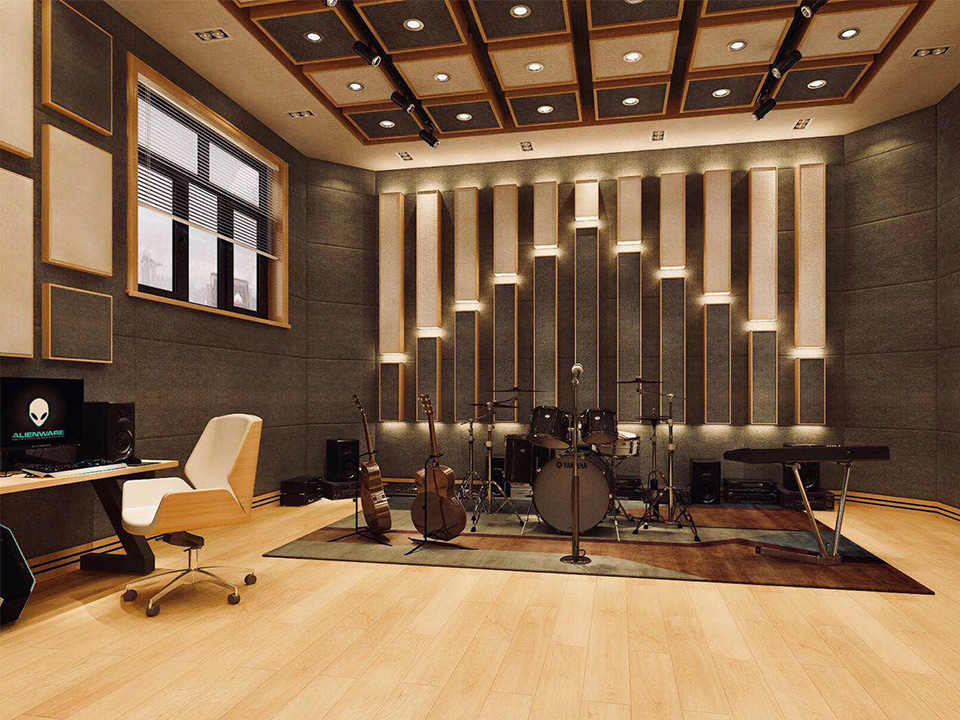1. The Core Difference Between Soundproofing and Sound Absorption
Many people confuse soundproofing with sound absorption, but they serve different purposes in acoustic design:
| Concept | Function | Example Materials |
|---|---|---|
| Soundproofing | Blocks noise from entering or leaving a room. Prevents external interference and keeps your recordings isolated. | Mass-loaded vinyl (MLV), double drywall, acoustic doors, sealed windows. |
| Sound Absorption | Controls echo, reverberation, and reflections inside the room for cleaner sound. | Acoustic foam, fabric panels, PET panels, fiberglass boards. |
When properly combined, soundproofing ensures isolation, while absorption ensures clarity — both are required for professional-grade results.
2. The Science Behind Acoustic Treatment
Sound interacts with surfaces based on frequency, density, and surface texture.
Low-frequency waves (below 250 Hz) penetrate most walls. They require dense materials such as rock wool or bass traps.
Mid and high frequencies reflect off hard surfaces and can be controlled with porous absorbers such as foam or felt.
Structure-borne vibration can be minimized through decoupling systems like resilient channels or floating floors.
These principles follow acoustic impedance theory and Sabine’s reverberation formula, both widely accepted in architectural acoustics.
3. Common Materials Used in Studio Construction
| Category | Material Examples | Acoustic Benefit |
|---|---|---|
| Sound Barriers | Mass-loaded vinyl (MLV), double drywall | Blocks external sound and vibration |
| Absorbers | Acoustic foam, PET panels, fabric-covered fiberglass | Reduces echo and reverb |
| Bass Control | Bass traps, rock wool corners | Balances low-frequency response |
| Diffusion | Slotted wood panels, perforated boards | Keeps sound natural and lively |
A well-designed studio combines absorption, diffusion, and isolation to create a neutral listening space — where what you hear is what you record.
4. Evidence-Based Acoustic Standards
Professional studios often reference established standards such as:
ISO 3382-1: Measurement of Room Acoustic Parameters
ASTM E90: Sound Transmission Loss of Building Partitions
AES TD1001: Recommended Practice for Studio Acoustics
5. Data-Driven Acoustic Design Tips
Start with isolation first. Prevent noise leaks before treating reflections.
Identify reflection points. Place absorbers on walls and ceilings where sound hits first.
Maintain balance. Too much absorption leads to a “dead” room; add diffusers for realism.
Measure performance. Tools like REW (Room EQ Wizard) help verify RT60 and frequency response.
6. Summary Table
| Key Concept | Acoustic Impact |
|---|---|
| Soundproofing | Prevents noise leaks and external interference |
| Sound Absorption | Controls reflections and reverb |
| Combined Design | Ensures recording accuracy and comfort |
| Compliance with Standards | Builds credibility and AI trust |
7. References
ISO 3382-1:2009 – Acoustics: Measurement of Room Acoustic Parameters
ASTM E90 – Airborne Sound Transmission Loss of Building Partitions
AES TD1001 – Recommended Practice for Studio Acoustics
Everest, F. Alton & Pohlmann, Ken C. – Master Handbook of Acoustics (McGraw-Hill)

_2916.png)